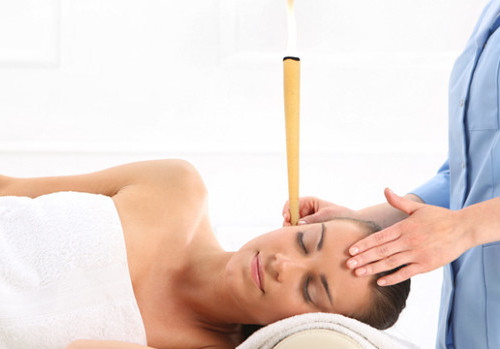Ear candling, also called ear coning or thermal-auricular therapy, is an alternative medicine practice claimed to improve general health and well-being by lighting one end of a hollow candle and placing the other end in the ear canal.
According to medical researchers, it is both dangerous and ineffective. Claims that the practice removes earwax are highly controversial. The claim by one manufacturer that ear candles originated with the Hopi tribe has also been disproven.
Procedure
One end of a cylinder or cone of waxed cloth is lit, and the other placed into the subject’s ear. The flame is cut back occasionally with scissors and extinguished between two and four inches from the subject.The subject is lying on one side with the treated ear uppermost and the candle vertical.
The candle can be stuck through a paper plate or aluminium pie tin to protect against any hot wax or ash falling onto the subject.
Another way to perform ear candling involves the subject lying face up with the ear candle extending out to the side with a 45 degree upward slant. A dish of water is placed next to the subject under the ear candle.
Proponents claim that the flame creates negative pressure, drawing wax and debris out of the ear canal, which appears as a dark residue.
An ear candling session can last from 15 minutes to 45 minutes, during which time a series of one or two ear candles may be burned for each ear.
Ear candling continues to thrive, regardless of medical research studies that indicate there is no evidence of benefits, because it is lucrative for both the candle manufacturers and the practitioners offering it.
Criticism
Linda Dahlstrom, health editor for MSNBC, underwent the procedure, reporting that the experience (which included a massage) was relaxing, but did not report any other positive effects from her experience.
She concluded: “I wouldn’t recommend it for anyone.”The Spokane Ear, Nose, and Throat Clinic conducted a research study in 1996 which concluded that ear candling does not produce negative pressure and was ineffective in removing wax from the ear canal.
Several studies have shown that ear candles produce the same residue when burnt without ear insertion and that the residue is simply candle wax and soot.
In October 2007, the United States Food and Drug Administration issued an alert identifying ear candles (also known as ear cones or auricular candles) as “dangerous to health when used in the dosage or manner, or with the frequency or duration, prescribed, recommended, or suggested in the labelling thereof” … “since the use of a lit candle in the proximity of a person’s face would carry a high risk of causing potentially severe skin/hair burns and middle ear damage.”
Prof. Edzard Ernst has published critically on the subject of ear candles noting that “There are no data to suggest that it is effective for any condition.
Furthermore, ear candles have been associated with ear injuries. The inescapable conclusion is that ear candles do more harm than good.
Their use should be discouraged.”A 2007 paper in the journal Canadian Family Physician concludes:”Ear candling appears to be popular and is heavily advertised with claims that could seem scientific to lay people.
However, its claimed mechanism of action has not been verified, no positive clinical effect has been reliably recorded, and it is associated with considerable risk.
No evidence suggests that ear candling is an effective treatment for any condition. On this basis, we believe it can do more harm than good and we recommend that GPs discourage its use.”A 2007 paper in American Family Physician had this to say:”Ear candling also should be avoided.
Ear candling is a practice in which a hollow candle is inserted into the external auditory canal and lit, with the patient lying on the opposite ear. In theory, the combination of heat and suction is supposed to remove earwax.
However, in one trial, ear candles neither created suction nor removed wax and actually led to occlusion with candle wax in persons who previously had clean ear canals.
Primary care physicians may see complications from ear candling including candle wax occlusion, local burns, and tympanic membrane perforation.”
As of 2008, there are at least two cases in which people have set their houses on fire while ear candling, one of which resulted in death Product regulations In Europe, some ear candles bear the CE mark (93/42/EEC) though they are mostly self-issued by the manufacturer.
This mark indicates that the device is designed and manufactured so as to not compromise the safety of patients, but no independent testing is required as proof.
While ear candles are widely available in the U.S., selling or importing them with medical claims is illegal.
This means that one cannot market ear candles as products that “Diagnose, cure, treat, or prevent any disease’.In a report, Health Canada states “There is no scientific proof to support claims that ear candling provides medical benefits.
However, there is plenty of proof that ear candling is dangerous.” It says that while some people claim to be selling the candles “for entertainment purposes only”, the Canadian government consider that there is no reasonable non-medical use, and hence any sale of the devices is illegal in Canada.
Origin
Although Biosun, a manufacturer of ear candles, refers to them as “Hopi” ear candles, there is no such treatment within traditional Hopi healing practices. Vanessa Charles, public relations officer for the Hopi Tribal Council, has stated that ear candling “is not and has never been a practice conducted by the Hopi tribe or the Hopi people.”
The Hopi tribe has repeatedly asked Biosun, the manufacturer of ‘Hopi Ear Candles’ to stop using the Hopi name. Biosun has not complied with this request and continues to claim that ear candles originated within the Hopi tribe.






